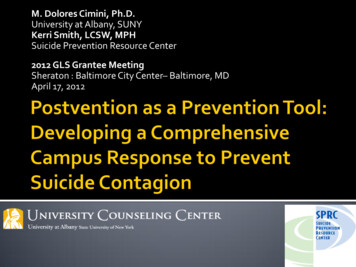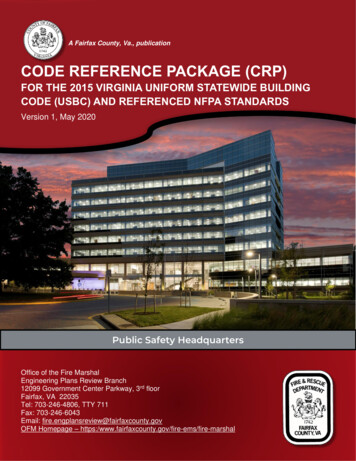
Transcription
M. Dolores Cimini, Ph.D.University at Albany, SUNYKerri Smith, LCSW, MPHSuicide Prevention Resource Center2012 GLS Grantee MeetingSheraton : Baltimore City Center– Baltimore, MDApril 17, 2012
1.Define postvention and its critical role in addressingand preventing suicide contagion;2.Identify the importance of involving keystakeholders in the development, implementation,and evaluation of postvention protocols;3.Identify and know how to address two keypostvention issues – utilizing social media after astudent suicide and planning memorial services with an aim to prevent suicide contagion.
Postvention as a Prevention Tool
“The provision of crisis intervention and othersupport after a suicide has occurred to addressand alleviate possible effects of suicide.” (SPRCPostvention Workgroup Definition) “ interventions occurring after a tragedy.”(Meilman, 2006) “The goal of postvention is to reduce thenegative impact of a suicide on ‘survivors.’”(Cerel, & Campbell, 2008)
“ Planning around one component impacts the planning (andultimately the effectiveness) of the other two areas.”(The Jed Foundation, 2006)5
A Protocol is Key
s-and-research/framework7
First responders Communications with the campuscommunity Communications with the media8
Types of support services Targeted outreach Debriefing with staff Lack of established protocol9
During protocol development: Include a broad base of stakeholders Define the terminology you will use Consider the ethnic, racial, cultural, and spiritual diversityof your student body(The Jed Foundation, 2006)10
Implementation: Determine how you will disseminate and educate the campuscommunity on protocol Identify a “point person(s)” to respond to all questions aboutthe protocol Engage in regular table-top exercises Develop a revision plan(The Jed Foundation, 2006)11
Addressing Student, Campus, & Community Needs
011/Recommendations14.pdf13
Sticking to protocol Preparation of materials prior to an incident Teachable moments
Distribution of information and resources Monitoring student and campus response to a studentsuicide Collaboration with family to: Ensure that families monitor deceased student’s socialnetworking sites Bypass privacy settings that might prohibit interventions Awareness of Facebook guidelines on reportingsuicidal online activity
Memorials for other types of deaths Multiple suicides Input from family Ensuring safe messaging Other ways to honor the deceased
http://www.whenthewhistleblows.gatech.edu/17
Questions?
Addressing Student Suicide through Postvention
University Center within 64-campus SUNY SystemUrban SettingResearch UniversityNCAA Division IStudents: Undergraduates Graduate Students -13,4574,977 Undergraduate Masters Doctorate -618939Faculty:Employees:Degree Programs:9674,19720
of UAlbanyComprehensive PreventionProgram21Comprehensive Program Presidential Leadership Campus Task Force: ”BRisk” Student Involvement/Leadership Social Marketing/Social Norms Campus-Community Partnerships Education Gatekeeper Training Early Intervention Policy Evaluation/Enforcement Parental Involvement Treatment & Referral Research and Program Evaluation
Spectrum of Intervention Response:Suicide PreventionThresholdsfor ActionSpecialized InterventionsEarly InterventionUniversal Prevention Stigma Reduction MediaCampaign Peer Services (PeerEducation and HotlineServices) Educational Brochures “Save-A-Life" GatekeeperTraining Program forFaculty, Staff, and Students PRISM (Proximate RiskIndex and ScreeningMeasure) Screenings Consultations with faculty,staff, students, and parents22 CARE Net (Consultation andResource Evaluation) Program Treatment and Referral Response to Urgent orEmergent Situations
The STEPS Comprehensive SuicidePrevention Program Model“Partnerships Working to Prevent Student Suicide One Step at a Time”23
Student death and other serious campusincidents Response guided by Responding to Students inCrisis protocol Suicide/homicide attempt or incident inwhich intent is evident Response guided by CARE Net (Consultation andResource Evaluation) Program protocol24
1)Provide support and assistance to the students in crisis and to insuretheir safety and the safety of others.2)Respond, as confidentiality regulations permit, to persons or groups suchas:a.b.c.d.the student’s parents, legal guardians, and/or significant others,the student’s friends, roommates, suitemates, and hall residents,various University offices to provide services and support to the student and otheraffected members of the University community,the University and Albany communities, as appropriate.3) Address system-wide issues surrounding the crisis.4) Work toward the prevention of similar crises in the future.25
Confidentiality Judgment Coordination Support26
Assess present suicide risk Evaluate student’s willingness and ability to refrainfrom threatened and actual self-injurious behaviors Provide consultation regarding recommendedpsychiatric, psychological, and educational services27
Minimize disruption of normal functioning forroommates and suitemates in the residencecommunity Augment existing crisis intervention services,psychological treatment resources, andconsultation with Residential Life staff andstudents28
Timeline February 2011 April 2011 May 2o11 Fall 2011 Spring 2012 Future Prevention Efforts29
Now let’s hear from you
Questions?
University at Albany Crisis Protocol and Postvention ulty/albany only/Postvention Workshop Session at the 2009 GLS Grantee genda010909.aspCDC Recommendations for a Community Plan for the Prevention and Containment of SuicideClusters: 00214.aspCentre for Suicide Prevention. School Memorials After a Suicide: Helpful or Harmful?: Available byrequest at http://suicideinfo.ca/AboutUs/ContactUs.aspxCerel, J. , & Campbell, F. (2008). Suicide survivors seeking mental health services: A preliminaryexamination of the role of an active postvention model. Suicide and Life-Threatening Behavior, 38(1), 3034.Clinician Survivor Task Force. Clinicians as Survivors: After a Suicide Loss:http://mypage.iusb.edu/ jmcintos/therapists mainpg.htmGeorgia Institute of Technology. When the Whistle rvard School of Public Health. Means Matter: http://www.hsph.harvard.edu/means-matter/The Jed Foundation. Framework for developing institutional protocols for the acutely distressedstudent: s-and-research/frameworkMaine Youth Suicide Prevention Program. Media Guidelines for School Administrators Who MayInteract with Reporters about Youth /program/mediaschool.htm32
Maine Youth Suicide Prevention Program. Youth Suicide Prevention, Intervention & PostventionGuidelines: A Resource for School Personnel: 009--w%20discl.pdfMeilman, P. W., & Hall, T. M. (2006). Aftermath of tragic events. The development and use of communitysupport meetings on a university campus. Journal of American College Health, 54(6), 382-384.National Suicide Prevention Lifeline. How to Report Suicidal Users on App rs%20on%20Facebook.pdfNational Suicide Prevention Lifeline. Lifeline Online Postvention ostventionManual.pdfRecommendations for Reporting on Suicide: http://reportingonsuicide.orgSally Spencer-Thomas. When Tragedy Strikes: Suicide Postvention on a College ntion-on-a-college-campus/SPAN USA & SPRC. Guide to engaging the media in suicide prevention:http://www.sprc.org/library/media guide.pdfSPRC. After a Suicide: Recommendations for Religious Services & Memorial de.pdfSPRC & AFSP. After a Suicide: A Toolkit for Schools: http://sprc.org/afterasuicideforschools.aspSPRC. Safe and Effective Messaging for Suicide ngfinal.pdf33
M. Dolores Cimini, Ph.D.Assistant Director for Prevention& Program Evaluationdcimini@albany.eduUniversity Counseling CenterUniversity at Albany, SUNY400 Patroon Creek Boulevard, Suite 104Albany, NY 12206Phone: 518-442-5800Fax:518-442-3096Website: www.albany.edu/counseling center/Kerri Smith, LCSW, MPHSenior Campus Prevention Specialistksmith@edc.orgSuicide Prevention Resource Center (SPRC)Education Development Center, Inc.43 Foundry Ave.Waltham, MA, 02453Phone: 617-618-2738Website: www.sprc.org
1) Provide support and assistance to the students in crisis and to insure their safety and the safety of others. 2) Respond, as confidentiality regulations permit, to persons or groups such as: a. the student ïs parents, legal guardians, and/or significant others, b. the student ïs friends, roommates, suitemates, and hall residents,











